There are 28 salamanders in Arkansas with some salamanders in the state being common in the United States (such as the tiger salamander and the redback salamander), while some others are unique to the state.
The Ouachita streambed salamander, the Rich Mountain salamander, and the Caddo Mountain salamander are only endemic to Arkansas.
Within the state, salamanders can be found statewide. However, the southern and eastern regions of the state have the most salamanders.
What are salamanders? These are amphibians under the order Urodela. These amphibians are lizard-like except for a few such as amphiumas which are eel-like in appearance. Salamanders are generally slender in appearance with narrow heads and four limbs.
Some adult salamanders possess gills however most do not. A large number of salamanders are lungless and respire through their skin (these include members of the Family Plethodontidae).
Some salamanders such as the western lesser siren, the red river mudpuppy, the three-toed amphiuma, and the Ozark hellbender are all fully aquatic. Most salamanders are terrestrial during a stage in their life cycle. This stage is generally adulthood although the central newt is only terrestrial as an eft (an intermediate stage between hatchling and adult).
Table of Contents
Salamanders in Arkansas
Family Ambystomatidae
Species under this family are generally referred to as mole salamanders.
1. Ringed Salamander

- Binomial Name: Ambystoma annulatum
- Adult Length: 5.5 to 10 inches (14 to 25.5 cm)
- Lifespan: 10 years
- Conservation Statuses: Species of Greatest Conservation Need (Arkansas Game & Fish Commission)
The species is endemic to the western portions of Arkansas. They have been reported in the Interior Highlands. Within the Arkansas Valley ecoregion, the species is endemic to Conway County, Petit Jean Mountain, Logan County, and Mount Magazine.
This is quite a large species. It is known as the ringed salamander because of the yellow rings around the underbody. The underside lacks the rings but is yellowish to grayish.
2. Spotted Salamander

- Binomial Nomenclature: Ambystoma maculatum
- Average Adult Size: 6 to 9.5 inches (15 to 24 cm)
- Lifespan: 20 to 30 years
The species occurs throughout the entire state of Arkansas.
This is quite a large salamander. It gets its common name from the yellowish/orangish suits on the body and head. The background color of the amphibian is dark blue. The spots are in two rows on the back. The underside is grayish.
3. Marbled Salamander
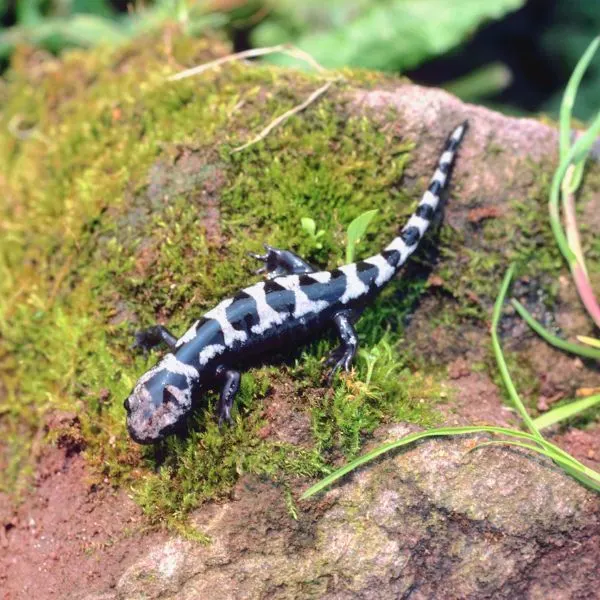
- Binomial Nomenclature: Ambystoma opacum
- Average Adult Size: 3.5 to 4.25 inches (9 to 10.7 cm)
- Average Lifespan: 3.5 years
The marbled salamander is black and marble (silvery white) in coloration. The coloration and the pattern on the skin make it look like it is made of marble. This appearance gives the species its common name. The pattern is broad silvery crossbands on a dark background. The underside is black.
The species is endemic to most of Arkansas apart from the northwest. The population in the Boston Mountains and Ozark Highlands.
4. Mole Salamander
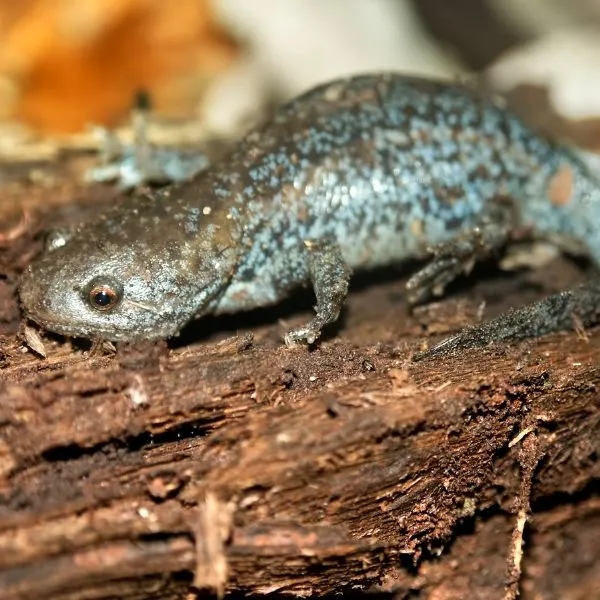
- Binomial Nomenclature: Ambystoma talpoideum
- Average Adult Size: 3 to 4 inches (7.5 to 10 cm)
- Lifespan: 10 to 20 years
- Conservation Statuses: Species of Greatest Conservation Need (Arkansas Game & Fish Commission)
The mole salamander is stocky with a large head. The species is dark in color. The coloration is grayish-brown with lichen-like patterns. The underside is grayish-blue. The underside normally has a darker stripe that is lengthwise.
The species is endemic to the northeast to central-east and southwest to central-west. The ranges include the southern Ouachita Mountains (along the Caddo River valley) and the lowlands of South Central Plains, from west of the Mississippi Alluvial Plain and the Saline River to the White and Black rivers.
5. Small-Mouthed Salamander
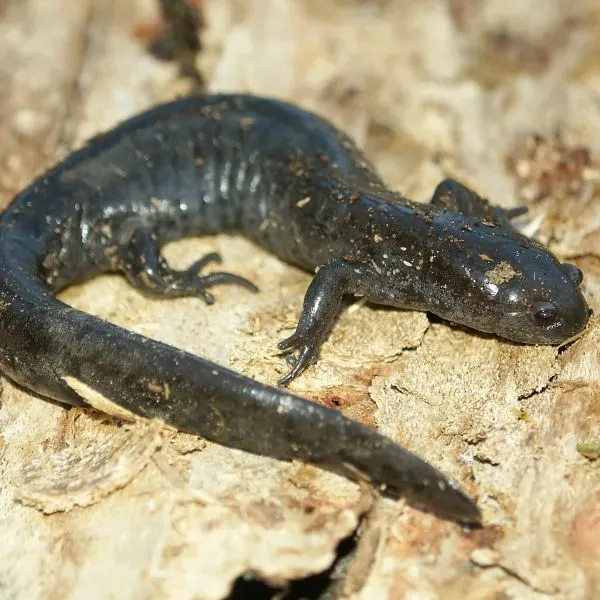
- Binomial Nomenclature: Ambystoma texanum
- Adult Length: 4.3 to 7 inches (11 to 17.8 cm)
- Lifespan: 5.3 years (in captivity)
The small-mouthed salamander is quite large. The amphibian is slender and has a narrow head. The coloration is dark with flecked patterning. The background color is grayish brown. The underside is black.
The species is endemic to most of the state. The only regions the species is mostly absent from are the northwest in the Boston Mountains and the Ozark Highlands. Isolated populations exist in Fairfield Bay in Cleburne County; Mountain View in Stone County; Fayetteville in Washington County: and Bentonville in Benton County.
6. Eastern Tiger Salamander
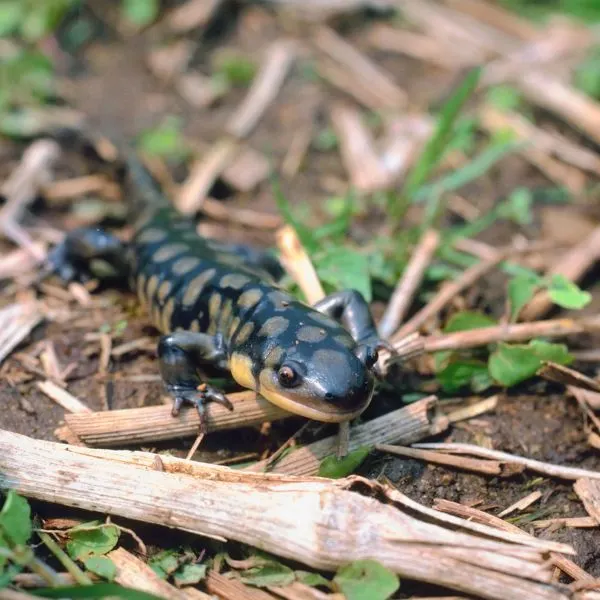
- Binomial Nomenclature: Ambystoma tigrinum
- Other Names: Tiger salamander, tiger
- Average Adult Length: 6.6 to 13 inches (17 to 33 cm)
- Lifespan: 25 years
- Conservation Statuses: Species of Greatest Conservation Need (Arkansas Game & Fish Commission)
The eastern tiger salamander is a black and yellow salamander. This mix of colors gives the amphibian its common name. This salamander is quite large. The background color is black to midnight blue to light brown. There are several yellow blotches with no defined pattern. The underside is black or gray with yellow mottles.
The species is endemic to northern Arkansas. There is an isolated population in the south. In north central Arkansas, the species is mostly endemic to Springfield Plateau. There is another wild population in the northwest. The species may have occurred throughout northern Arkansas in the past however, the occurrence is mostly limited to northcentral Arkansas. There may be an isolated population in southwest as the species has been recorded in Lewisville in Lafayette County.
Family Amphiumidae
Species under this family Amphiumidae are amphiumas.
7. Three-toed Amphiuma
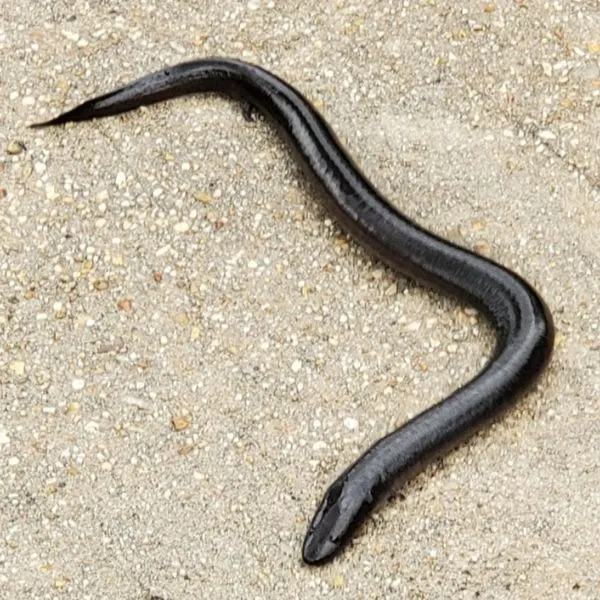
- Binomial Nomenclature: Amphiuma tridactylum
- Average Adult Size: 18 to 30 inches (46 to 76 cm)
- Lifespan: 27 years
A. tridactylum is a large amphibian. This foot-long amphibian closely resembles an eel and is fully aquatic. It has four really tiny and diminutive legs which each has three toes. These limbs aren’t used for movement and perform no function. They are vestigial. Although the amphiuma is aquatic, it lacks external gills.
The species is endemic from southern Arkansas to northeastern Arkansas. It is endemic to the Mississippi Alluvial Plain and the South Central Plains to Morrilton, Conway County. The species may also be endemic to southern Polk County.
Family Cryptobranchidae
These include hellbenders.
8. Ozark Hellbender

- Trinomial Nomenclature: Cryptobranchus alleganiensis bishopi
- Adult Length: 11 to 23 inches
- Conservation Statuses: Endangered (US Fish & Wildlife Service )
The hellbender endemic to Arkansas is the Ozark hellbender. This is a subspecies of the hellbender and is named after the ozark Highlands.
The Ozark Hellbender is huge. The background color is grayish and covered in dark blotches. The huge hellbender has four limbs like all other salamanders and has five toes on its hind feet. The skin is wrinkled and looks too big for its body. Although fully aquatic, the species lack external gills.
The species has a limited wild population in Arkansas and is endemic to the extreme northeast with another possible small occurrence in the northwest. While the population in the Eleven Point River used to be robust, there are very few individuals remaining.
Family Plethodontidae
This family includes lungless salamanders.
9. Ouachita Dusky Salamander

- Binomial Nomenclature: Desmognathus brimleyorum
- Total Length: 7 inches (17.8 cm)
D. brimleyorum is a tiny salamander that is brownish to grayish. There are little to no patterns on the skin. The underside is also uniformly colored. The tail is fin-like. This shape helps it to swim effortlessly when it needs to.
The species occur in the western portion of the state south of the Arkansas River. The species is the most common and most abundant in the Ouachita Mountain streams. The species is also endemic to the South Central Plains. Here it is found in spring runs and sandy soil springs.
10. Spotted Dusky Salamander
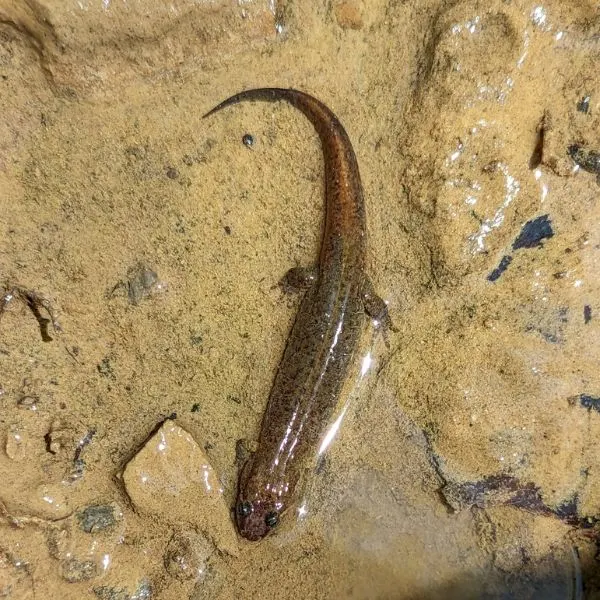
- Binomial Nomenclature: Desmognathus conanti
- Adult Length: 2.5 to 5 inches (6.4 to 12.7 cm)
- Conservation Statuses: Species of Greatest Conservation Need (Arkansas Game & Fish Commission)
While the species used to be endemic to Arkansas, it hasn’t been spotted since 1972 and as such is believed to be extirpated. Historically, the species has been endemic to the eastern side of Crowley’s Ridge.
The species is similar in appearance to other dusky salamanders. D. conanti is tiny and is brownish to grayish in color. These s[ecies have tiny dark s[pts on the upper body, particularly on the sides. The underside is also uniformly colored. The tail is fin-like.
11. Grotto Salamander Complex

- Binomial Nomenclatures: Eurycea spelaea, Eurycea braggi, Eurycea nerea
- Adult Length: 3 to 5.3 inches (7.5 to 13.5 cm)
- Lifespan: 12 years
- Conservation Status: Regulated (US Fish & Wildlife Service )
Similar to other members of the genus Eurycea, the grotto salamander lives in caves. This is a small salamander. It is mostly white in color with four limbs. The hind limbs have four toes and the front limb has three toes. The eyes on this salamander are beady and fused to the eyelids.
The species is endemic to northern Arkansas. Wild populations exist in the northern portions of the Boston Mountains, the karst topographies of the Ozark Highlands.
Eurycea braggi occurs centrally in the range and covers the area colored red in the distribution map. E. spelaea is in the west of the range and covers the area colored green in the distribution map. E. nerea is in the eastern portion of the range and covers the area colored blue in the distribution map.
12. Cave Salamander

- Binomial Nomenclature: Eurycea lucifuga
- Adult Length: 4.9 to 7.1 inches (12.5 to 18.1 cm)
- Life Span: 9 years
E. lucifuga is known as the cave salamander because it inhabits caves. It isn’t the only salamander that inhabits caves. In fact, most of the species within the genus Eurycea inhabits caves. E.lucifuga mostly inhabit mouths of caves and other cool moist habitats. The species is bright orange with several dark spots over the upper body including the head, tail and limbs.
The species is endemic to northern regions of Arkansas. The species’ wild population in arkansa include the northern regions of the Boston Mountains and the karst topographies of the Ozark Highlands.
13. Dark-sided Salamander

- Binomial Nomenclature: Eurycea melanopleura (also considered a subspecies of Eurycea longicauda as Eurycea longicauda melanopleura)
- Adult Size: 4 to 8 inches (10 to 20 cm)
E. melanopleura is yellowish with dark spots on the back. The sides are darker and have gray spots. The tail also has darker sides. E. melanopleura inhabits caves and other cool and moist habitats.
E. melanopleura and E. longicauda hybridize in the extreme northeastern portion of their range. E. melanopleura is endemic to the northern portion of the state. It lives in the northern regions of the Boston Mountains and the karst topographies of the Ozark Highlands.
14. Many-ribbed Salamander

- Binomial Nomenclature: Eurycea multiplicata
This is a tiny salamander that comes in a variety of colors. It is usually yellowish and grayish in color. The underside is more lightly colored and is usually light yellow or light gray. The back is darker in color. This species is the commonest south of the Arkansas River.
The species is endemic to the Ouachita Mountains. It is found in the mountainous regions of the Arkansas Valley. It is mostly endemic to the regions south of the Arkansas River.
15. Western Dwarf Salamander

- Binomial Nomenclature: Eurycea paludicola
This is a tiny and slender salamander with a narrow head. The species have four limbs each with four toes. The coloration is brown with two dark stripes that go from behind each eye to the tip to the tail. There are gray and black flecks on the sides of the body.
The species is endemic to the south central region of Arkansas specifically in the South Central Plains. The species coexist along the E. multiplicata in the environs of Caddo Valley in Clark County.
16. Ouachita Streambed Salamander

- Binomial Nomenclature: Eurycea subfluvicola
- Conservation Status: Regulated (US Fish & Wildlife Service)
This is a tiny salamander and simply resembles the larvae of other species of the genus Eurycea. It is fully aquatic and doesn’t undergo metamorphosis. It is known as a paedomorphic species. It is tiny and brown in color.
The species is only found in one location – the Slunger creek valley of the Lake Catherine State Park.
17. Oklahoma Salamander

- Binomial Nomenclature: Eurycea tynerensis
- Adult Length: 4.1 inches (10.5 cm)
- Lifespan: 10 years
- Conservation Status: Species of Greatest Conservation Need (Arkansas Game & Fish Commission)
Similar to other species of the genus Eurycea, this is a tiny and slender salamander. It comes in a variety of colors but it is mostly yellowish or grayish. The back is usually of a darker shade than the rest of the body. The underside is of a lighter shade and is yellowish or grayish as well.
The species is endemic to northern Arkansas, north of the Arkansas River. Some of the wild populations are neotenic and as such do not undergo metamorphosis.
The species is endemic to the Arkansas valley, Boston Mountains, and Ozark Highlands north of the Arkansas River.
18. Four-toed Salamander
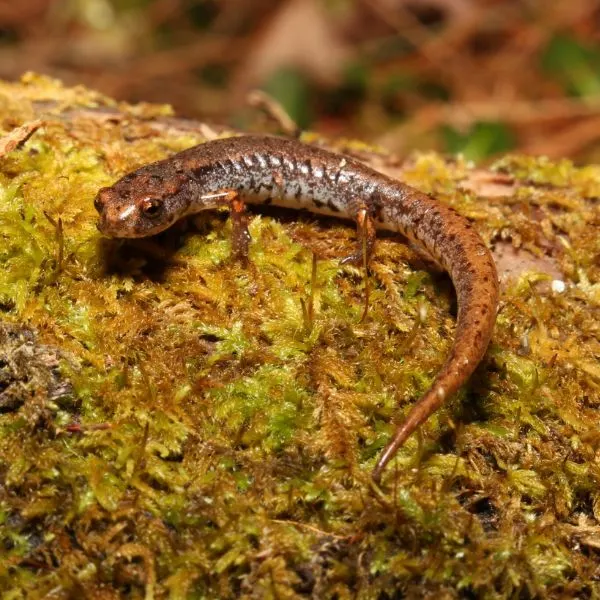
- Binomial nomenclature: Hemidactylium scutatum
- Adult Size: 2 to 3.5 inches (5.08 to 8.89 cm)
- Lifespan: 5.5 years (female in captivity)
This is a rare salamander within the state. It is reddish-brown with a white belly that has tiny black spots. H. scutatum has four toes on each limb. Most salamanders have five toes on their hind limbs but not the four-toed salamander.
The species is endemic centrally and to the west of the state. Most of the population is in the Ouachita Mountains. There is a disjunct wild population near Wolf Bayou in Cleburne County.
19. Slimy Salamander Complex
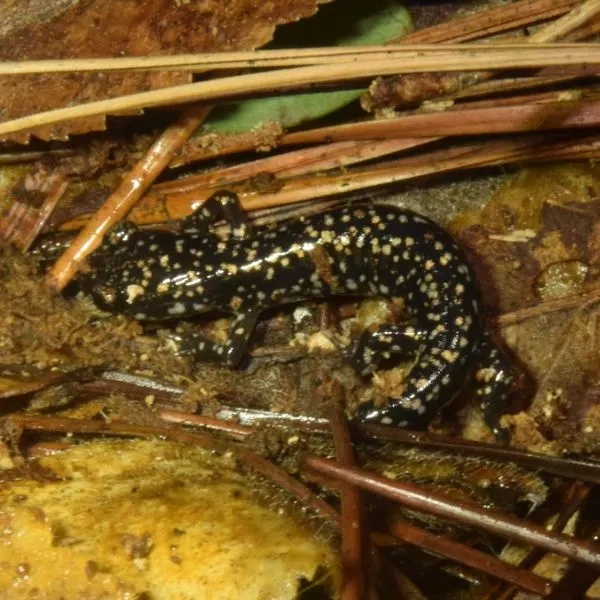
- Total Length: 2 to 3 inches
- Conservation Status: Species of Greatest Conservation Need (Arkansas Game & Fish Commission) (for P. kiamichi and P. kisatchie only)
- Western Slimy Salamander
- Binomial Nomenclatures: Plethodon albagula
- Louisiana Slimy Salamander
- Binomial Nomenclatures: Plethodon kisatchie
- Kiamichi Slimy Salamander
- Binomial Nomenclatures: Plethodon kiamichi
The slimy salamander complex is the most common slimy in arizona. The species is black with many white flecks. These flecks resemble stars against the night sky. The underside is dark gray, so is the chin.
This salamander is known as the slimy salamander because of glue-like slime it secretes when threatened.
The western slimy salamander (P. albagula) is endemic to most of the state. The green coloration on the map refers to P. albagula.
Louisiana slimy salamander (P. kisatchie) is endemic to the extreme south portion of Arkansas, west of the Ouachita River. This species’ range is colored blue on the distribution map.
Kiamichi slimy salamander (P. kiamichi) is endemic to the eastern edge of the Kiamichi Mountain range in Polk County and to the Arkansas-Oklahoma border in the Ouachita Mountains. This species’ range is colored red on the distribution map.
20. Ozark Zigzag Salamander
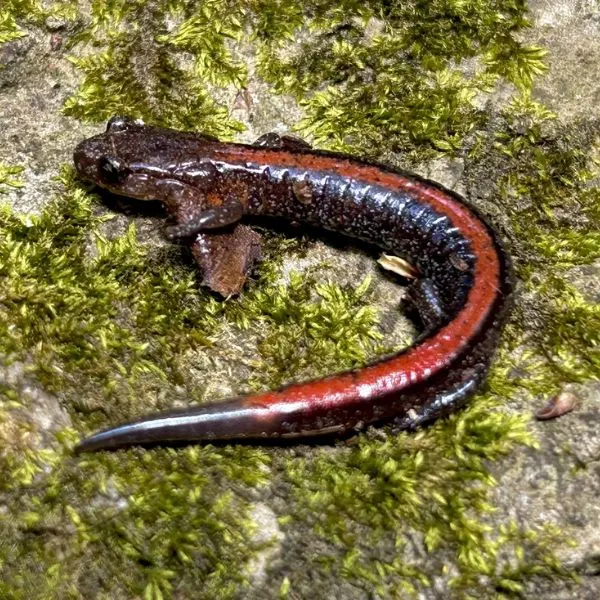
- Binomial Nomenclature: Plethodon angusticlavius
- Adult length: 2.3 to 4 inches (5.8 to 10.2 cm)
This species has a red (sometimes greenish yellow) stripe down its back. The margins of the stripe has an irregular way or zigzag pattern which gives the species its common name. Some individuals lack this stripe and are referred to as leadback.
The species is endemic to the northwestern portion of Arkansas. The amphibian’s range include the Boston Mountains, and the Ozark Highlands. The range also extends to the northeastern regions of the Arkansas valley in the northern portion of White County.
21. Caddo Mountain Salamander

- Binomial Nomenclature: Plethodon caddoensis
- Species of Greatest Conservation Need (Arkansas Game & Fish Commission)
This species is endemic to the Caddo Mountain and its environs in Polk, Pike, Montgomery, and Howard counties. The species is small and black. It has several flecks on the skin which are whitish in color. The underside is dark but the chest and chin are whitish.
The species’ geographic range is found in the western portion of Caddo Mountain. Caddo Mountain is part of the greater Ouachita Mountains.
Within the tiny distribution map with four colored areas, the red colored part of its range include the Little Missouri and Cossatot rivers; the orange colored part of the range includes the Upper Caddo River; the green colored part of the range includes Brushy Creek; and the blue colored part of the range include Lower Caddo River.
22. Fourche Mountain Salamander

- Binomial Nomenclature: Plethodon fourchensis
- Species of Greatest Conservation Need (Arkansas Game & Fish Commission)
This is an uncommon salamander and is endemic to Fourche and Iron Forks mountain ranges of Scott County, Polk County, and Montgomery County. The species is named after the Fourche Mountain, where it is endemic.
P. fourchensis is stockier than other mountain salamanders. It is black in color with two rows of licken-like blotches and tiny speckles. The underside is dark with white specks. The chin is pale.
The species is endemic to Iron Forks and Fourche Mountains. Within its geographic range, it can be found in western Fourche, Little Brushy, Buck Knob, and Blue Mountain.
23. Rich Mountain Salamander

- Binomial Nomenclature: Plethodon ouachitae
- Max Length: 2 inches
- Conservation Status: Species of Greatest Conservation Need (Arkansas Game & Fish Commission)
This amphibian is found only in Arkansas. Within the state, it is endemic to Rich Mountain (where it is named after), Kiamichi Mountain, and Black Fork Mountain.
The species’ dorsum is black and maroon with flecks on the back. The underside/ventrum is dark and the chin is pale.
24. Southern Redback Salamander

- Binomial Nomenclature: Plethodon serratus
- Average Adult Size: 3 to 4 inches (8 to 10.5 cm)
The redback salamander has a reddish stripe down its back. This stripe gives the species its common name. Unlike the zigzag salamander, the margins of the stripe are regular though each serration matches a costal groove. There are individuals with no middorsal stripes known as leadback. The rest of the body is reddish with white specks.
Within the state, the species is endemic to the Ouachita Mountains.
Family Sirenidae
These include sirens.
25. Western Lesser Siren
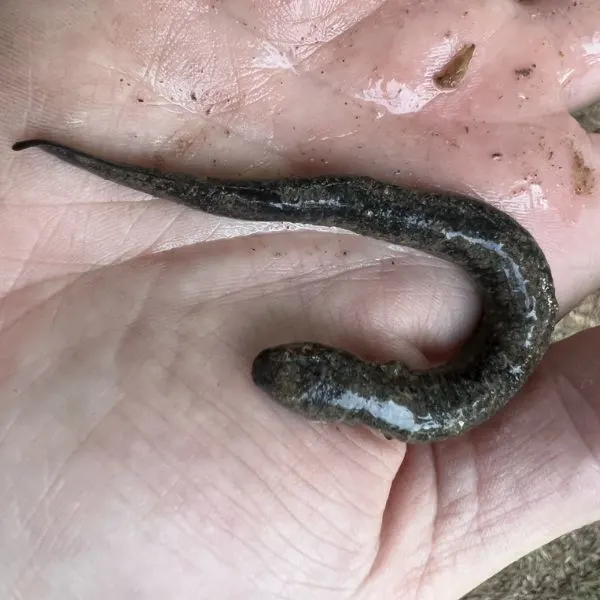
- Trinomial Nomenclature: Siren intermedia nettingi
- Average Adult Length: 17 inches (43 cm)
- Lifespan: 6 years
The lesser siren endemic to Arkansas is the western lesser siren. This is a subspecies. The western lesser siren is fully aquatic. It has only two front limbs which have 4 or 5 toes. As with other sirens, the species have gills. The siren is eel-like and its limbs are tiny.
The species occurs in the south to the northeast. This range includes the Mississippi Alluvial Plain and the South Central Plains to the southern Ouachita Mountains. The range goes up to Arkansas Valley to Pope County.
Family Proteidae
This family includes water dogs and mudpuppies.
26. Red River Mudpuppy
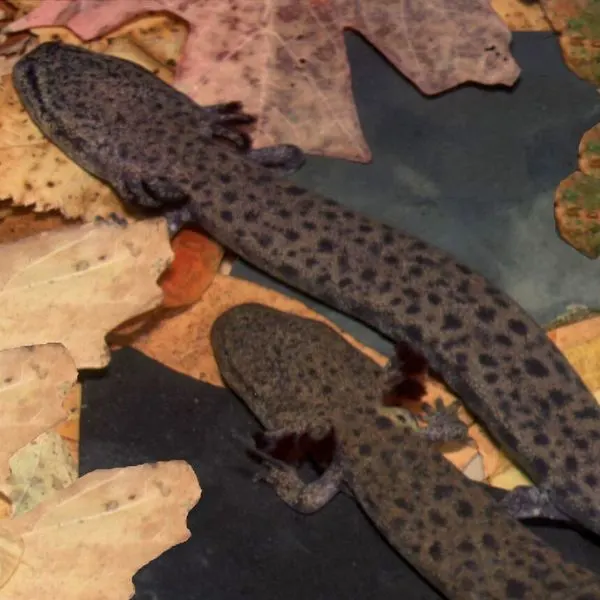
- Binomial Nomenclature: Necturus louisianensis
The Red River mudpuppy is huge. Its background color is red to gray. The species has dark blotches on the skin. Similar to other salamanders, the Red River mudpuppy has four limbs. A noticeable characteristic of the species are its large red external gills which look bushy.
As you can tell from the distribution map, the species inhabited most permanent water bodies, such as streams and rivers, within the state.
Family Salamandridae
These include newts.
27. Central Newt
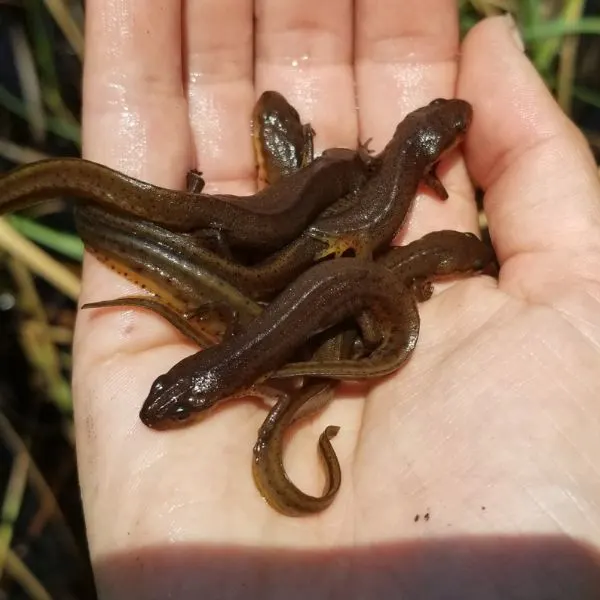
- Trinomial Nomenclature: Notophthalmus viridescens louisianensis
- Adult Length: 2.3 to 4.8 inches (5.8 to 12.2 cm)
- Eft Length: 1.5 to 3.5 inches (3.8 to 8.9 inches)
The central newt is a subspecies of the eastern newt. This newt is aquatic as adults and as hatchlings. It has an intermediate terrestrial stage known as eft. The skin of the species is rough and dry.
The central newt is yellowish to olive with several specks on the body. A stripe can be seen across the eyes.
The species is endemic to most of the state.
Frequently Asked Questions
How many different species of salamander live in Arkansas?
There are quite a lot of salamanders endemic to the state. In all, there are about 28 species of salamander in the state.
The latest species to be discovered is the Ouachita Streambed Salamander. These salamanders occur mainly in the southern and eastern regions of Arkansas.
Out of the many salamanders in the state, the western lesser siren, the red river mudpuppy, the three-toed amphiuma, and the Ozark hellbender are all fully aquatic.
What is a salamander?
Salamanders are amphibians under the order Urodela. These amphibians are generally lizard-like in appearance although a few such as amphiumas resemble eels. Salamanders generally have long slender bodies, narrow heads, and four short limbs.
What are the salamanders that live in the Ozarks?
The Ozark highlands is home to a great number of animals which include several salamanders.
The salamanders found in this region include the marbled salamander (Ambystoma opacum), small-mouthed salamander (Ambystoma texanum), Ozark hellbender (Cryptobranchus alleganiensis bishopi), grotto salamander (Eurycea spelaea, Eurycea braggi, and Eurycea nerea ), cave salamander (E. lucifuga), dark-sided salamander (E. melanopleura), Oklahoma salamander (Eurycea tynerensis), and Ozark zigzag salamander (Plethodon angusticlavius).
What are the salamanders that live in the Boston Mountains?
The Boston Mountains are home to several salamanders. Some of these salamanders include marbled salamander (Ambystoma opacum), small-mouthed salamander (Ambystoma texanum), grotto salamander (Eurycea spelaea, Eurycea braggi, and Eurycea nerea ), cave salamander (E. lucifuga), dark-sided salamander (E. melanopleura), Oklahoma salamander (Eurycea tynerensis), and Ozark zigzag salamander (Plethodon angusticlavius).
What are the reptiles and amphibians of Arkansas?
There are about 119 reptiles and amphibians in the state of Arkansas. Some of the more common amphibians and reptiles endemic to the state include the western rat snake, the three-toed box turtle, and the American bullfrog.
Conclusion
There are many salamanders endemic to Arkansas. Some such as the Ouachita streambed salamander, the Rich Mountain salamander, and the Caddo Mountain salamander are only endemic to Arkansas. In all, there are 28 salamanders endemic to the state.
Within the state, most salamanders are endemic to the southern and eastern regions.
So what are salamanders? Well, salamanders are amphibians from the order Urodela. They generally have four limbs and are lizard-like in appearance. Of course, this isn’t true of all salamanders. A few are eel-like such as amphiumas. These still have limbs although the limbs are vestigial and as such are nonfunctional.
Some popular salamanders in the state include the tiger salamander, the redback salamander, and the mudpuppy.
Other nearby states
